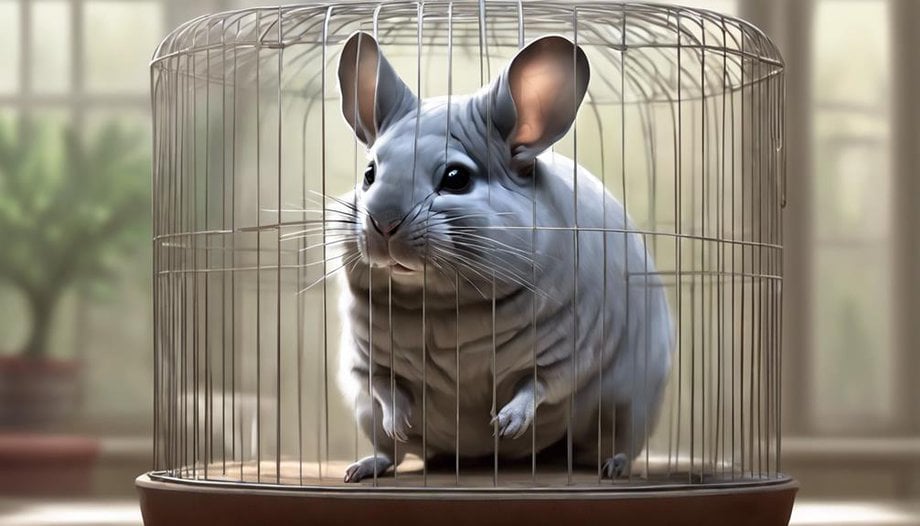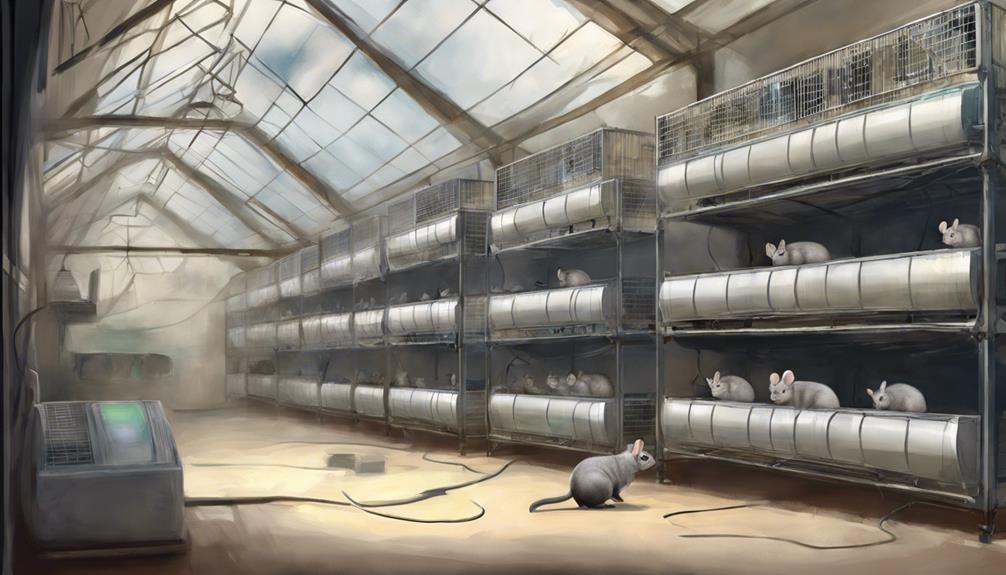Why Proper Ventilation Is Crucial in Chinchilla Housing

The Importance of Proper Ventilation in Chinchilla Housing:
Air quality directly impacts chinchillas' health and well-being.
Adequate ventilation is crucial for their comfort and overall health.
Proper air circulation helps maintain a healthy environment for these cherished pets.
Key Takeaways
- Proper ventilation ensures chinchillas' health and comfort.
- Inadequate airflow leads to respiratory issues and heat stress.
- Implement ventilation strategies to maintain a healthy environment.
- Regular monitoring and adjustment optimize chinchilla housing conditions.
Importance of Ventilation for Chinchillas
Proper ventilation is essential for chinchillas to maintain peak health and well-being in their housing environment. Ventilation benefits these small creatures by ensuring that fresh air circulates throughout their living space, providing them with the best conditions necessary for thriving. Chinchilla behavior is greatly influenced by the quality of air circulation within their habitat. When chinchillas are housed in well-ventilated environments, they exhibit increased activity levels, display more natural behaviors, and generally appear more content.
Air circulation directly impacts chinchilla comfort. Adequate ventilation helps regulate temperature and humidity levels, preventing the buildup of stale air that can lead to respiratory issues and discomfort for these sensitive animals. Chinchillas are known for their thick fur coats, and proper ventilation plays an important role in preventing them from overheating. By ensuring a well-ventilated living space, chinchilla owners can significantly enhance the overall well-being and happiness of their furry companions.
Signs of Poor Ventilation in Chinchilla Cages
Inadequate ventilation in chinchilla cages can manifest through various observable signs, indicating potential risks to the chinchillas' health and well-being. Signs of poor ventilation in chinchilla cages can be subtle but are important to recognize for the welfare of these delicate animals. Monitoring the airflow within the cages is essential to guarantee a healthy environment for the chinchillas. Here are some common signs that may indicate poor ventilation in chinchilla cages:
| Signs of Poor Ventilation | Description | Potential Risks |
|---|---|---|
| Accumulation of moisture | Damp bedding and walls | Respiratory infections |
| Stale odor in the cage | Lingering musty smell | Respiratory issues |
| Presence of mold or mildew | Visible mold spots | Respiratory illnesses |
| Chinchillas panting | Excessive breathing | Heat stress |
| Lethargic behavior | Lack of energy and movement | Respiratory problems |
Proper ventilation is key to maintaining a healthy chinchilla environment; monitoring airflow and ensuring adequate air circulation are essential practices for chinchilla owners.
Health Risks Associated With Inadequate Airflow
Adequate airflow in chinchilla housing is vital to safeguarding the health and well-being of these delicate creatures. Inadequate airflow can pose significant health risks that chinchilla owners must be aware of to guarantee the longevity of their pets.
- Respiratory Distress: Poor ventilation can lead to a build-up of harmful ammonia fumes from urine, causing respiratory distress in chinchillas.
- Mold and Mildew: Insufficient airflow creates a damp environment prone to mold and mildew growth, which can trigger respiratory illnesses in chinchillas.
- Allergic Reactions: Dust and dander accumulate in stagnant air, increasing the risk of allergic reactions and respiratory issues in chinchillas and their owners.
- Heat Stress: Inadequate ventilation can result in poor air quality control, leading to heat stress in chinchillas, especially in warmer climates or during the summer months.
Proper ventilation isn't merely a matter of comfort; it's a vital aspect of chinchilla care that directly impacts their health and quality of life. Owners must prioritize adequate airflow to prevent respiratory illnesses and maintain the best air quality control within chinchilla enclosures.
Tips for Improving Ventilation in Chinchilla Enclosures
To enhance the airflow within chinchilla enclosures, consider implementing strategic ventilation adjustments. Adequate air circulation is paramount in maintaining a healthy living environment for these small creatures. Ventilation improvements can be achieved by introducing adjustable vents or windows that allow for the regulation of airflow. By strategically placing these vents, one can guarantee a constant flow of fresh air while preventing any stagnation or drafts that may be harmful to chinchillas.
Additionally, incorporating exhaust fans can aid in expelling stale air and promoting better circulation throughout the enclosure. It's essential to monitor the effectiveness of these improvements regularly to make sure that the air quality remains optimum for the chinchillas' well-being.
Best Practices for Maintaining Proper Airflow

Maintaining proper airflow within chinchilla enclosures is important for their overall well-being and health. Ensuring good air quality is essential as it directly impacts their respiratory health. To promote ideal airflow and create a healthy environment for chinchillas, consider the following best practices:
- Natural Ventilation: Encourage natural airflow by placing cages in well-ventilated areas. Fresh air circulation is key to preventing stale, harmful air from accumulating.
- Regular Cleaning: Keep cages clean by removing waste and soiled bedding frequently. A clean environment not only reduces odors but also promotes better air quality.
- Proper Cage Placement: Position cages away from drafts and direct sunlight. This helps maintain a stable temperature and airflow within the enclosure.
- Air Purification: Consider using air purifiers or plants known for their air-purifying properties to enhance the quality of air in the chinchilla's living space.
Ventilation Solutions for Chinchilla Habitats
Encouraging ideal airflow in chinchilla habitats is paramount for ensuring their health and well-being. Ventilation fans and filters play a critical role in maintaining a healthy environment for these small creatures. Properly installed ventilation fans help to circulate fresh air throughout the habitat, preventing the buildup of harmful ammonia and other pollutants. Filters are essential in trapping dust, dander, and other airborne particles that could pose a risk to chinchillas' respiratory health.
In addition to mechanical ventilation solutions, harnessing natural airflow through windows can also greatly improve air quality within the habitat. Opening windows strategically allows for the exchange of stale indoor air with fresh outdoor air, promoting a more natural and invigorating living environment for chinchillas.
Monitoring and Adjusting Ventilation Levels

Proper monitoring and adjustment of ventilation levels in chinchilla housing is essential to guarantee ideal living conditions for these delicate creatures.
Ventilation equipment placement, airflow rate adjustments, and maintaining appropriate temperature and humidity levels are key factors that must be carefully considered.
Ventilation Equipment Placement
Position the ventilation equipment strategically within the chinchilla housing to guarantee ideal air circulation and adjust levels as necessary for the well-being of the animals. Proper placement guarantees efficient airflow, maintaining a healthy environment for your chinchillas.
Here are essential factors to contemplate:
- Natural Light: Assure ventilation equipment placement allows for natural light to enter, creating a balanced and comfortable atmosphere.
- Noise Reduction: Position fans and ducts to minimize noise disturbance, promoting a tranquil setting for your chinchillas to thrive.
- Accessibility: Place ventilation equipment for easy access during maintenance, ensuring a seamless process without causing stress to the animals.
- Air Quality: Regularly monitor airflow to sustain optimal air quality, safeguarding the health and happiness of your chinchillas.
Airflow Rate Adjustment
To guarantee ideal air circulation and maintain a healthy environment for chinchillas, vigilantly monitor and adjust ventilation levels as needed.
Adjusting airflow is a critical aspect of ensuring that your chinchilla's housing provides the best environment for their well-being. By implementing effective ventilation strategies, you can regulate the airflow rate to prevent the buildup of harmful gases and maintain proper air quality.
Regularly evaluating and fine-tuning the ventilation levels will help create a comfortable and safe living space for your chinchillas. Remember, proper ventilation is essential for their respiratory health and overall happiness.
Stay attuned to their environment, making necessary adjustments to keep the airflow at a top-notch level.
Temperature and Humidity Control
Regularly monitoring and adjusting ventilation levels is paramount in controlling temperature and humidity for ideal chinchilla housing conditions. To guarantee a harmonious environment for these delicate creatures, one must adhere to precise temperature regulation and humidity control.
Here are four essential considerations to keep in mind:
- Maintaining the perfect balance: Striking a balance between warmth and moisture levels is critical for the chinchillas' well-being.
- Ensuring ideal air quality: Proper ventilation not only regulates temperature and humidity but also guarantees a fresh and healthy atmosphere.
- Promoting comfort levels: By monitoring ventilation, chinchilla owners can create a space where these adorable animals feel safe and content.
- Enhancing overall vitality: A well-ventilated environment contributes greatly to the chinchillas' overall health and vitality.
Frequently Asked Questions
Can Chinchillas Get Respiratory Infections From Poor Ventilation?
Insufficient ventilation can lead to respiratory infections in chinchillas. Preventive measures include ensuring proper airflow in their housing. Treatment options may involve veterinary care and medication. Adequate ventilation is essential for chinchilla health and well-being.
How Often Should Chinchilla Cages Be Cleaned to Ensure Good Airflow?
Regular cage cleaning is crucial for maintaining good airflow and air quality. Neglecting ventilation maintenance can increase health risks for chinchillas. To guarantee their well-being, a thorough cleaning schedule should be followed to promote a healthy environment.
Are There Specific Types of Bedding or Substrate That Can Help With Ventilation?
To guarantee proper ventilation in chinchilla housing, consider bedding options like aspen shavings or paper-based substrates. These materials allow airflow, fostering a healthy environment for chinchillas. Remember, fresh air is crucial for their well-being.
Can Using a Fan or Air Purifier Help Improve Airflow in a Chinchilla Enclosure?
Using a fan or air purifier can indeed help improve airflow in a chinchilla enclosure. These tools aid in proper air circulation, improving ventilation, and maintaining perfect temperature control. Consider incorporating humidifiers for added benefits.
Are There Any Specific Plants or Herbs That Can Aid in Air Circulation in a Chinchilla Habitat?
Indoor plants act as nature's air purifiers, enhancing air circulation in chinchilla habitats. Certain herbs like basil and mint can provide both aromatic pleasure and cleaner air, promoting a healthier environment for chinchillas to thrive.











